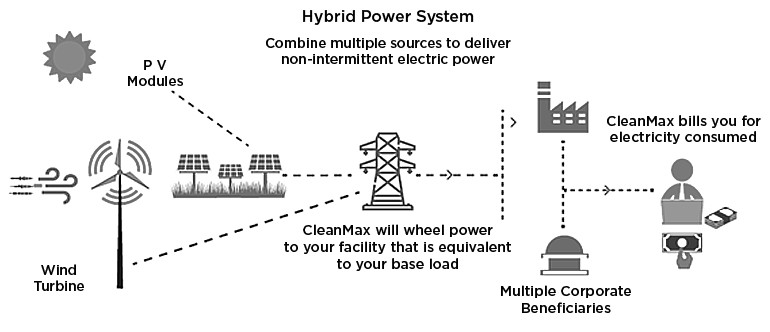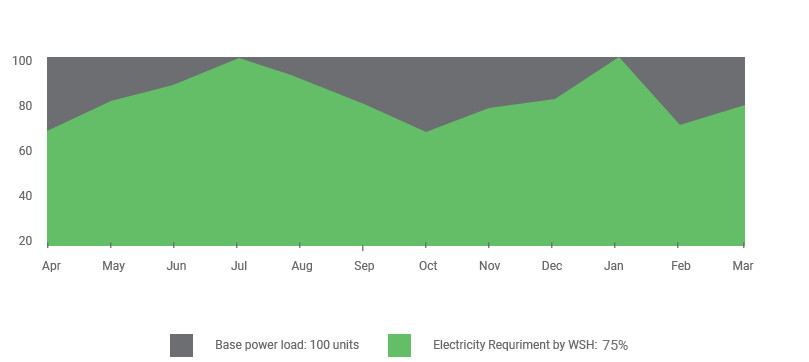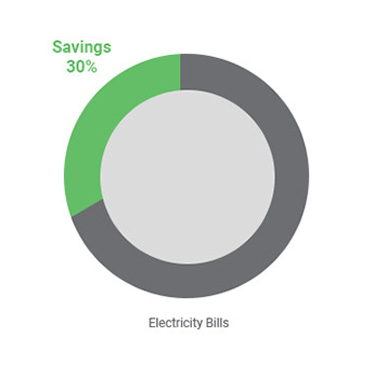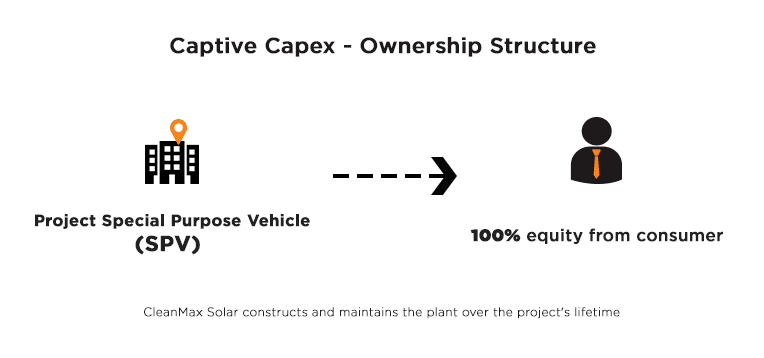What if we told you that the average clean renewable energy delivered to large corporates can be increased by integrating wind and solar farms to provide a hybrid supply. Wind Solar Hybrid presents an opportunity to harness the complementary nature of solar power and wind power.
A Wind Solar hybrid plant generates power in a continuous pattern, with much less variability than a standalone solar plant (generates only during daylight hours) or standalone wind plant (generates mainly during evening/night).
The Wind Solar Hybrid solution ensures high Plant Load Factors (PLFs) and offers a highly efficient as well as stable energy source.
The Hybrid power system combines power from solar panels and wind turbines to produce uninterrupted electric power, and the combined supply is wheeled by SSK Green Max to your respective facilities in a pattern that matches your base load.
Solar and wind power plants share the same evacuation infrastructure; hence the fixed costs and transmission charges are lowered and also the power becomes less susceptible to curtailment because of its regular generation pattern.
Corporates can utilise the non-intermittent power they need, equivalent to their base load, and pay for only power used, at tariffs lower than prevailing grid electricity tariffs.

* Example:
The below graph showcases the benefit of procuring power from the Wind Solar Hybrid Farm.
Let’s assume that this large corporate has a need for continuous & constant power load of 100 units throughout the year 24x7.
In this example, power procurement through solar plant alone can only cater to 60 units i.e. for every 100 units of electricity required only 60% of power can be substituted by Solar , while wind alone can only cater to 50 units i.e. for every 100 units electricity required only 50% of power can be substituted by Wind.
But the power procurement through a Wind Solar Hybrid farm can supply up to 75 units i.e. for every 100 units of electricity required 75% of the power requirement can be substituted by Wind Solar Hybrid Farm with little to no reliance on banking. In this example, the customer can achieve around 30% savings on their annual electricity bills versus 20% to 25% from wind or solar alone, due to the larger proportion of power supplied.


*Disclaimer: The information presented above is for educational purposes only. All the data provided in the article above are approximate values derived from third party sources, research articles or on ground experience and SSK Green Max would take no responsibility or have any obligation over the correctness of data.







No Regulatory Risks

30-40%
More Renewable Energy = More savings

100% Optimum non intermitted power supply matching your base load 24x7
SSK Green Max is developing private WSH farms in Karnataka and Gujarat, to enable us to help corporates meet their sustainability objectives while providing supply of low-cost normalized power supply matching your base load 24x7 across different seasons for years to come, without taking unnecessary risks.
You can choose to procure non-intermittent power supply using any of the below models.
At SSK Green Max, we can meet all your business electricity needs by supplying renewable energy from our offsite private Solar farms, Wind farms and Wind Solar Hybrid (WSH) Farms across India. Open access power tariffs are much cheaper than grid tariffs. Moreover, this model allows consumers to overcome the limitations of onsite solar installation, as it is a scalable option which is not constrained by availability of space at your facility. With open access power, you begin to enjoy affordable renewable energy from day one.
There are many reasons businesses like yours are considering renewable power over conventional power. For industrial and commercial consumers, open access power translates into regular electricity supply at a lower cost, while also helping reduce their carbon footprint.





Since this is an energy sale model, there is no upfront investment required from the consumer.
Electricity purchased from SSK Green Max will be at a tariff much lower than grid tariffs, resulting in energy cost savings on every unit provided.
With zero investment and upkeep responsibility, this is a capex-free, hassle-free, and risk-free solution.
By getting into a PPA with us, you will have fixed tariff for the next 20-25 years which is cheaper than prevailing grid electricity tariffs.
Contractual Challenges:
Operational Challenges:
Regulatory Challenges:
In the captive capex model, the corporate buyer for a utility scale renewable project makes the upfront capital investment. The buyer owns the power generating asset and the solar power generated is used for the corporate buyer’s self-consumption. SSK Green Max constructs the plant and operates and maintains it over its lifetime.




Open Access charges from the grid are applicable, but unpredictable charges, such as cross-subsidy surcharge and additional surcharge, are waived off in captive and group captive projects.
Under this structure, a corporate buyer who holds the asset on its balance sheet is also eligible to claim tax benefits through accelerated depreciation.
SSK Green Max will provide complete turnkey EPC solution while commissioning the plant with necessary regulatory approvals and due diligence. In addition, SSK Green Max will also operate and maintain the plant over its lifetime of 25 years.
The corporate buyer should ensure that a Group Captive project is fully compliant with the spirit of the law, and with the Electricity Act and the proposed amendments to the Electricity Rules by following two simple guidelines:
A variant of the captive model is the group captive model. Under the group captive model, a project is developed for the collective usage of one or many corporate buyers. SSK Green Max sets up a Special Purpose Vehicle (SPV) for group captive wherein the corporate buyer(s) holds only 26 percent of equity in a project and needs to collectively consume at least 51% of the power with the PPA. Here too, SSK Green Max will take complete responsibility for building, operating, and maintaining the project.



The corporate buyer can avail open access benefits of a group captive project without being required to completely own the project. Here, SSK Green Max will bear 74% of the investment – with the corporate buyer holding at least 26% equity. This is done to meet the ownership criteria that will allow exemption of cross-subsidy surcharge.
Even though the user is required to purchase electricity from SSK Green Max through a Power Purchase Agreement (PPA), it comes at much lower rates than prevailing grid tariffs, resulting in guaranteed savings on every unit consumed.
SSK Green Max will provide complete turnkey EPC solution while commissioning the plant with necessary regulatory approvals and due diligence. In addition, SSK Green Max will also operate and maintain the plant over its lifetime of 25 years.
The corporate buyer should ensure that a Group Captive project is fully compliant with the spirit of the law, and with the Electricity Act and the proposed amendments to the Electricity Rules by following two simple guidelines: